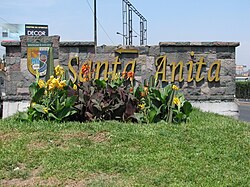Santa Anita | |
|---|---|
 | |
| Location of Santa Anita in the Lima province | |
| Country | |
| Region | Lima |
| Province | Lima |
| Founded | October 25, 1989 |
| Capital | Santa Anita |
| Subdivisions | 1 populated center |
| Government | |
| • Mayor | Olimpio Alegría (2023-2026) |
| Area | |
• Total | 10.69 km2 (4.13 sq mi) |
| Elevation | 195 m (640 ft) |
| Population (2023) [1] | |
• Total | 232,739 |
| Time zone | UTC-5 (PET) |
| UBIGEO | 150137 |
| Website | munisantanita.gob.pe |
Santa Anita is a district of the Lima Province in Peru. It is part of city of Lima. Officially established as a district on October 25, 1989, from parts of Ate and El Agustino separated by the Rio Surco, a ditch which went all the way to Santiago de Surco.
Contents
The current mayor ( alcalde ) of Santa Anita is Olimpio Alegría Calderón. The district's postal code is 43. The core sections of Santa Anita are: Santa Anita proper, originally a section of Ate; and Los Ficus and Universal, originally sections of El Agustino. Industrial areas to the east of Santa Anita and Universal mark the boundary with Ate.

